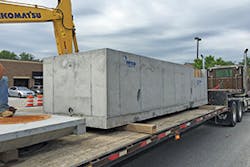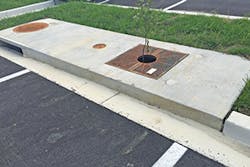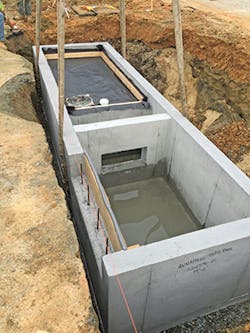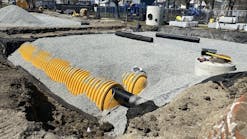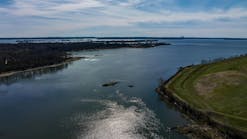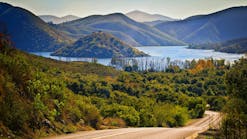Project Profile: Gray Combined With Green—Retrofit of Existing Bioretention Facility With High-Flow Bioretention Technology
Surface stormwater treatment practices have a common use in development projects to provide collection and control of contaminants generated from runoff from impervious surfaces. Common surface stormwater treatment practices include wet ponds, grass swales and channels, and bioretention facilities. Grass swales and bioretention facilities rely upon filtration provided by the vegetation and soil cross section to remove and contain contaminants. These facilities typically occupy a significant surface footprint to have sufficient capacity to capture the majority of runoff from rainstorms, as the filtration rates are relatively low. Due to the high levels of both runoff volume and contaminant concentration, surface stormwater treatment practices implemented in highly urbanized areas can suffer various modes of failure that require extensive repair and reconditioning to remain functional. In addition, as systems of this type age, they can present aesthetic challenges (compared to landscape-only site features), which can impact the ability of the site to operate as intended from the standpoint of attracting tenants and shoppers.
A small commercial flex-office development in Anne Arundel County, MD, was built in phases starting in 2003. Surface bioretention facilities were constructed to collect stormwater runoff from impervious surfaces and provide water-quality control. These facilities are essentially closed depressed channels within the parking areas into which the pavement drainage is directed. Despite ongoing maintenance conducted by the site owner, by 2015 the largest bioretention system had begun to demonstrate several failure modes, most notably clogging of the bioretention surface and failure of the asphalt pavement edges surrounding the perimeter of the facility. These failures resulted in reduction of aesthetic quality and would have required extensive rebuilding of the facilities, at a large expense, to correct the appearance and to restore the water-quality function of the facilities. The failure needed to be addressed to restore the curb appeal of the building space available for lease at the site.
The consulting firm, Bay Engineering, of Annapolis, MD, proposed an innovative solution to repairing and replacing the bioretention cell. Rather than simply selecting a stormwater practice from the list of acceptable local and state options, Bay Engineering chose Filterra high-flow bioretention systems to provide water-quality control. Filterra has cost-effective installation and maintenance requirements. This approach also allowed the existing bioretention facility to be abandoned and replaced with more traditional landscaping.
The Filterra technology is a high-flow bioretention system used to directly collect and filter stormwater runoff from pavement, building rooftops, and other pollution-generating impervious surfaces. It consists of a proprietary filter media placed in a prefabricated tank and planted with vegetation. Runoff is directed into the tank, to be quickly and completely discharged through an exit pipe at the bottom of the unit as contaminants such as trash, debris, sediment, oils and greases, and nutrients are captured. Filterra units are comparable to standard storm drain inlets (curb opening type) in terms of arrangement and function in pavement; in most applications the Filterra unit is simply placed as an opening in the curb and gutter and located at the appropriate collection point in terms of specific area of drainage to the facility. On this site, the first flush of runoff is directed to the Filterra units for treatment via the newly installed curb and gutter; two units are placed on opposite sides of the existing drainage and configured as mirror images of each other. Treated and bypass discharge flow is directed to the underground storm drain system; the discharge from the Filterra exits via an integral underdrain pipe, and bypass flows enter the existing riser overflow from the original bioretention facility.
Speed and cost control were of the highest priority in terms of installing the two Filterra units, abandoning the existing bioretention cell, and replacing it with more traditional landscaping. Installing the two Filterra systems was quick and easy. Being completely prefabricated, including the internal piping and filter media, the units were simply trucked to the site and offloaded into place like any standard inlet. The entire process for both units was completed in a few hours. The protected throat opening was left in place during the remainder of the construction process. Once the final paving and site stabilization took place, a crew from the supplier of the Filterra systems performed the “activation” of each facility, which included planting the selected vegetation (not yet mature), placing the 3-inch mulch layer and rock cobble scour protection, removing the throat protection, and taking the corresponding data and photographs to document the process.
The free edges of asphalt pavement were replaced with a concrete curb and gutter. The depressed areas of bioretention were replaced with clean fill. Grass and trees were planted as landscaping inside the curbed area. A clean, pleasing look—one that better matches the look of the office buildings and the relatively young age of the office park—was achieved successfully.
In summary, the originally constructed bioretention facility was not able to function and meet the curb-appeal needs of the site owner. The economics of replacing the system and restoring it was not feasible. Using an innovative treatment device—in this case the Filterra system—in conjunction with more standard landscaping islands was the most logical alternative. In addition, the use of a prefabricated system provided for the shortest possible window of time within which to complete the work and minimize the disruption to the tenants of the nearby offices. This option also allowed for the use of curbing for the edge of pavement, providing for a cleaner look and worry-free solution with respect to maintenance of the pavement and drainage. Maintenance of the Filterra system is predictable and reasonable—remove and replace the top 3-inch mulch layer twice a year and pump out the wet forebay every other year—which will allow for easy budgeting for operation and maintenance for the long term. In addition, the fully prefabricated nature of the Filterra system helped to keep the construction costs predictable and the timeline short, as the business park was open during construction.
